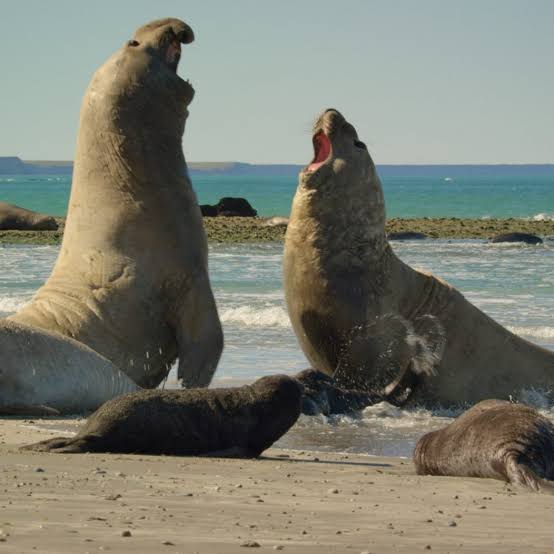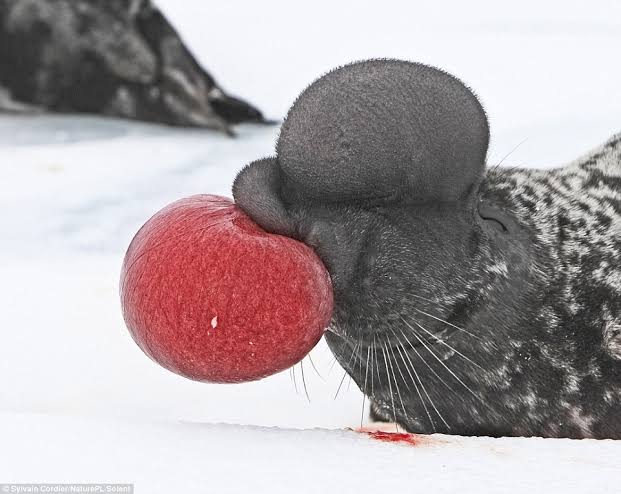Weird Animal Behaviors

April 20, 2025
•19 min read
Here are some unusual and downright weird animal behaviors!
The things that animals do can be outright breath-taking, but sometimes they’re just downright weird. Even though we’ve co-existed with animals for millions of years, they can still surprise us with strange behaviors that on the surface don’t make a lot of sense! From odd displays of domination, to trying to eat themselves whole, let’s take a closer look at why some animals do what they do.
Crocodiles Eating Rocks
If you looked inside a crocodile or alligator’s stomach, you’d probably see the remains of prey like fish and birds, along with any other animals they’d gobbled up! But there’d also be a rather intriguing addition to the menu: a pile of rocks! Almost like a side dish, those colossal crocodilians occasionally chow down any rocks they can find!
But what on earth would drive those mammoth reptilians to swallow a portion of pebbles? Obviously, it’s not for the nutritional value or the taste! Though there are a couple of theories explaining why they engage in that tooth cracking behavior; and one is that it aids their digestion.Manatees Control Their Buoyancy With Farts
Manatees are sea creatures that once inspired the myth of mermaids, thanks to their graceful movements and the seriously strong booze those sailors must have been drinking! Because if they’d taken a more sober look, they might have noticed that those bulbous sea dwellers were swimming around using their farts.
The Intelligence Of Crows
Have you ever been called a birdbrain? You might think someone was calling you stupid, but it could have been a compliment that is, if that bird brain belonged to a crow! Those black feathered flyers are often credited as some of the smartest animals on the planet, and with good reason. The crafty corvids have learned how to fashion and use certain tools to help them get out-of-reach food.
Zebra Finch Mating Habits
In the bird world, trying to find an attractive mate can be a real hassle. A lot of female birds invest huge amounts of energy into finding and breeding with males that have the best plumage, size, or nest. But not for the Zebra Finch! Those tiny birds find that the size and stamina of their mate is what sets them apart from the rest, as larger and fitter birds can better provide for their nest.
But if the wily female of that bird breed ends up with a small and unfit partner, she’ll lay much larger than average eggs that contain a lot more nutrients. Because Zebra Finches mate for life, the female has no reason to save up her resources for another, better partner. That means that the low genetic quality of the male is compensated for by good egg quality!While nutrients can’t overcome genetic coding, a larger egg does give the chick inside a lot more nourishment, meaning it can grow larger and has a better chance of surviving once it hatches! That’s one weird way of compensating for an unfit father!Pistol Shrimp Bubble Bullet
Measuring in at just over an inch and a half long, the pistol shrimp doesn’t look like it could do anyone or anything much harm! But that unassuming little creature has a deadly weapon hidden up its sleeve or in other words, in its claw! That gigantic pincer has a snapping mechanism that can snap shut at a shocking 60 mph! When it suddenly clamps down, the force results in a sound that can reach a deafening 218 decibels, that’s louder than most gunshots.
Capybaras Eat Their Own Poop
Capybaras are arguably the largest and most adorable rodents in the world. Able to grow up to 2 ft at the shoulder, and weighing up to 143 lbs, those semi-aquatic rodents are closely related to the equally adorable guinea pig! While they like their super-small relatives enjoy a diet of fruit, grasses, and vegetables, they also like to indulge in a hideous homemade treat: their own poop.
Cow Compass
Back in 2008, scientists began to notice a remarkable behavior in one of earth’s most unremarkable animals: cows. Thanks to the launch of the Google Earth tool, scientists were able to see that cattle all around the world weren’t just standing about randomly in their fields. A significant proportion of them appeared to be lined up on a north to south axis, almost like they were aligning themselves with the earth’s magnetic poles!
How a scientist discovered on Google Earth that cows align themselves North/South when grazing or resting. And how follow up studies revealed deer do this as well ow.ly/uZxr30nUXHK
Female Brown Trout Faking Orgasms
Some women can think they’re pretty savvy in the bedroom, and for one reason or another try to fake certain carnal shenanigans. But they’re not the only species that can fake it! Scientists from Sweden's National Board of Fisheries discovered that female brown trout also fake it when they mate!
During their reproductive cycle, both the male and female fish of courting pairs quiver with their mouths open when they release their eggs and sperm. However, female fish often quiver without releasing their eggs, and the poor dude falls for it every time!Dragonfly Faking Their Own Deaths To Avoid Males
While female trout seem to have it good, mating for some female dragonflies can turn into a desperate fight for survival! If the females aren’t lucky, hyper-aggressive males can injure or even kill them if they’re coerced into the ultimate carnal act! And it’s gotten so bad, that females have started going to a hilariously extreme to avoid mating with pestering partners, they fake their own deaths!
In 2017, a scientist in Switzerland witnessed a female moorland hawker dragonfly being harassed by aggressive males. All of a sudden, she dramatically dropped out of the sky, crashed on the ground, and lay completely motionless. It looked like she’d died from the sheer exhaustion from having to deal with so many annoying males!
Alcoholic Vervet Monkeys
Humans love to indulge in an alcoholic beverage every now and again, but we’re not the only species that enjoys a cheeky tipple! Scampering about on the Caribbean islands of St Kitt, Nevis, and Barbados, the local population of Vervet Monkeys are notorious for their love of the devil’s juice! In their quest for the taste of hooch, they’ve been known to steal entire bottles of booze from bars and swipe cocktails from unsuspecting tourists!
Buffalo Herd Democracy
The American electoral votes are a never ending nightmare for the nation, but in the animal kingdom, displays of democracy are ironically much simpler. Across the grassy plains of the African continent, herds of African Buffalo astoundingly cast votes on which direction they believe they should travel before moving on.
But obviously they’re not doing that by filling out a ballot! According to scientific observations, those cattle purposefully shift positions while they’re resting. But that isn’t to get comfy! By changing the direction they’re facing, they’re casting their own vote on which way they think the herd should travel, and the head female will move the herd off in that direction!In other words, African Buffalo herd movements are guided by a majority vote. Although that looks like incredibly progressive behavior, not every buffalo gets a say, because only the females can cast the deciding votes! Looks like democracy isn’t the only thing humans share with African buffalo, even the males refuse to ask for directions!Self-Eating Snake
Have you ever seen a cat attacking its own tail? It’s pretty hilarious. Although there’s nothing weirder or more frightening than watching a snake do the same thing.
Goats And Heights
Everything in our world adheres to the law of gravity that is, except for goats. Several subspecies of those four hooved heretics make an absolute mockery out of physics with their utterly insane climbing abilities. The magnificent mountain goats of North America, for example, have adapted to spend most of their lives careering across steep, rocky mountainsides.
And over the pond in the European alps, Alpine Ibex can clamber expertly up just about anything even practically vertical brick dams! Along with their remarkable sense of balance, they have slightly soft, cloven hooves which spread their weight into the rocky crevices and grip on tight!They’ve evolved to do so in order to reach high growing moss, lick salt from rocks, and get to tasty fruits and leaves at the tops of trees. While their behavior does technically make sense, seeing a herd of goats climbing a tree like these goats in Morocco are apt at doing is enough to blow even Einstein’s mind!Fainting Goats
While some goats are clearly fearless, there’s another truly bizarre breed that completely freezes at the slightest scare!
Aggressive Australian Magpies
Black and white Eurasian Magpies are known all over the world for their incredible plumage and brilliant brains. In fact, they’re widely considered to be one of the smartest birds in the world, a trait that sadly isn’t shared by their hyper-aggressive Australian cousins. Those frightening flyers perform dangerous dive bombs on innocent people strolling past their nests, as one incredibly unfortunate kid found out:
The Strange Mating Technique Of Hooded Seals
When trying to impress a lady, some men puff up their chests to make themselves look a bit more buff. But when male hooded seals are trying to attract a mate, they puff up something drastically different! By closing off one nostril, the seal blows and inflates an elasticated membrane in his nasal cavity! The sac is then pushed out and presented like a big red clown nose, which gets its color from all the blood vessels running across the stretchy membrane.
Also shout out to... - Southern Elephant Seals: sexually dimorphic, dive to 2km depth, largest pinnipeds - Hooded seals: balloon nose 🎈 - Ross seals: large eyes, mysterious aliens?? 👽 - Hawaiian Monk seals: eels in nose
The Changing Colors Of Reindeer Eyes
Reindeer are best known for Rudolph’s fictional glowing red nose, but scientists have discovered that those animals genuinely do change their color but in a different way! Astoundingly, the backs of their eyeballs change color from gold in the summer to blue in the winter. That is all because of changes in their tapetum lucidum or “cats eye”, a mirrored layer that sits just behind their retinas.

Owl Sitting Crisscross Applesauce
Early in 2020, a viral sensation swept the world that left people scared and confused. Twitter user jvonne78 brought the world’s attention to a photo of an owl sitting "criss-cross applesauce".
Embed for https://x.com/jvonne78/status/1228064871524294667 could not be displayed
Considering no one has ever witnessed a bird sitting with its legs crossed like a yoga aficionado before, the internet began to ask if owls can really sit cross legged. While the deceptively long legs of those amazing birds look like they could bend like pretzels, the heart-breaking truth is that they actually cannot sit "criss-cross applesauce". Owl legs have backwards bending joints, so they physically can’t bend them like those of a human.The owl is actually sitting on its hocks, which are the backwards bending joints between the birds thigh and its lower leg. It’s a resting behavior seen in many birds, although few of them have as many frontal feathers as that little owl. So, it would seem that the lay of those feathers is creating the illusion that the bird knows a few killer yoga poses!Starling Murmurations
Just before dusk, skies around the world are suddenly blacked out by shapeshifting clouds that turn, twist, and loop in bizarrely beautiful patterns. But those aren’t clouds! They’re actually flocks of thousands of starlings. And when they perform those impossible acts of choreography high in the sky, they’re called a murmuration.












](https://beamazed.b-cdn.net/dfhvoxjgb/image/upload/v1717910749/crazy-ways-animals-give-birth/1NMFOUk7J18mGJx5NqoPDT.jpg?width=400)






